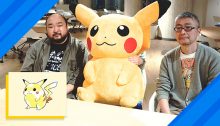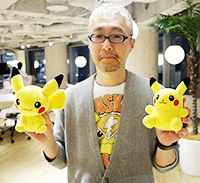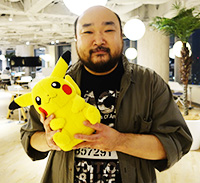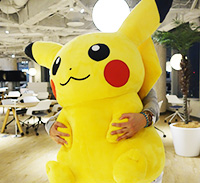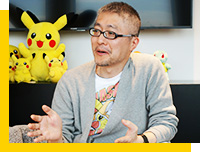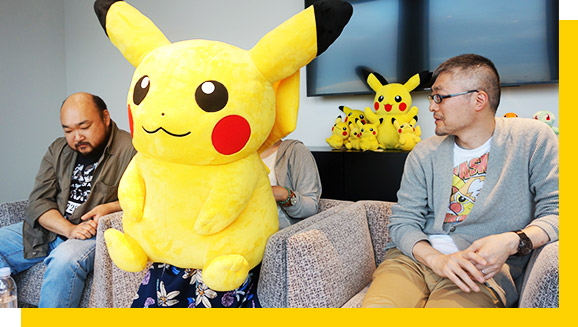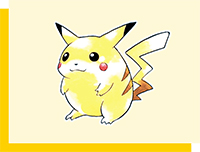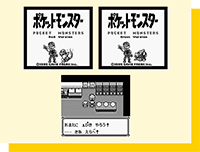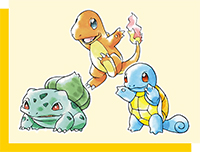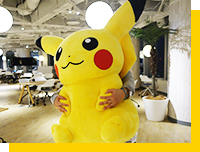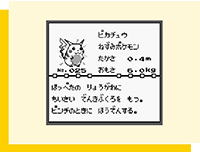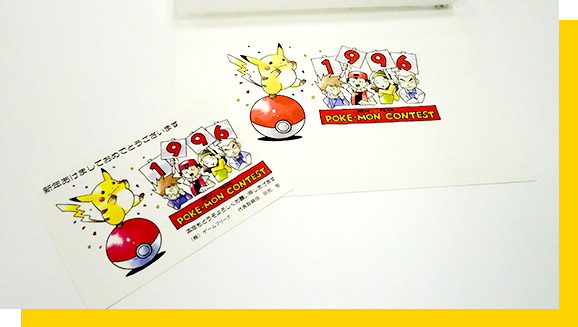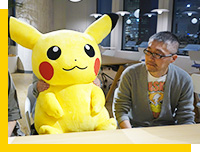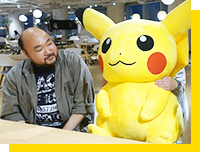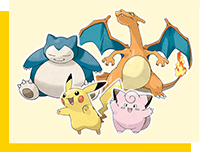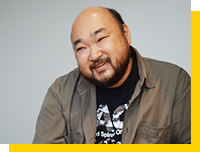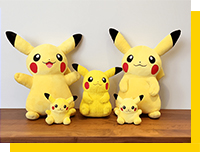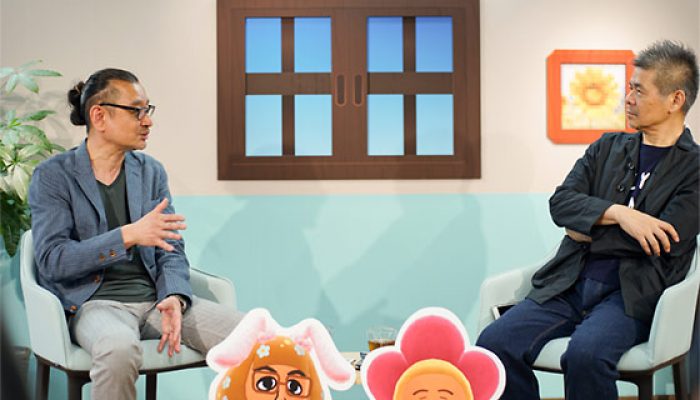 And so the key person in the design of Pikachu, Bulbasaur, Charmander and Squirtle is actually a woman: Atsuko Nishida.
And so the key person in the design of Pikachu, Bulbasaur, Charmander and Squirtle is actually a woman: Atsuko Nishida.
☆ NintendObs Weekly – Monday, July 23, 2018 – Sunday, July 29, 2018.
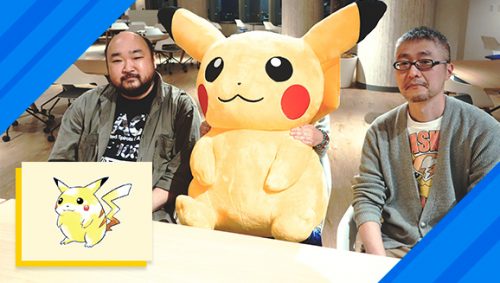
Creator Profile: The Creators of Pikachu
Learn Pikachu’s origin story from Ken Sugimori, Koji Nishino, and Atsuko Nishida.
July 26, 2018
Two years prior to the release of Pokémon Red and Pokémon Blue in the United States, Pokémon Red and Pokémon Green launched in Japan in 1996 for Nintendo Game Boy. It was a hit and drew many fans, especially children. The games’ popularity spread beyond Japan, and soon people around the world became familiar with the creatures known as Pokémon. Among the many Pokémon introduced, the most famous was—and still is—Pikachu.
In Pokémon Red and Pokémon Green, Pikachu appears not as one of the first partner Pokémon the main character chooses—which are Bulbasaur, Charmander, and Squirtle—but as one of the many wild Pokémon caught during the game.
What made Pikachu so popular? Certainly the fact that Pikachu is adorable is a contributing factor. But looking back on Pikachu’s original design reveals a plumper, somewhat different form than the Pikachu of today.
One of the main reasons Pikachu gained such popularity was the broadcast of the animated Pokémon TV series. Appearing as the partner Pokémon to the main character Ash, Pikachu captivated audiences with its bright yellow body and red cheeks, together with its “Pika!” cry. Pikachu’s popularity only grew, appearing not only in the Pokémon TV series but in movies as well. Pikachu now shows up in a lot more places, such as appearing at events and on many Pokémon products.
Until now, the origin of the creation of Pikachu hasn’t been told in detail. What were the ideas and stories behind the design of Pikachu when it first appeared in the games Pokémon Red and Pokémon Green? How was the beloved Pikachu created? The secret story is finally ready to be revealed—22 years after the game’s release.
The Main Actors Behind Pikachu’s Origin Story
We spoke with three creators who developed Pokémon Red and Pokémon Green and were deeply involved with the creation of Pikachu.
Ken Sugimori is one of the founding members of GAME FREAK Inc. He was in charge of the official character design for Pokémon Red and Pokémon Green. He is currently a director at the company.
Koji Nishino is a planner for GAME FREAK Inc. His main role in the original Pokémon Red and Pokémon Green games was data design, including field maps and the appearance rate and strength of Pokémon.
Atsuko Nishida was a character designer for Pokémon Red and Pokémon Green. She currently helps with character design for the Pokémon series as a freelance illustrator.
“I want some cute ones, too!”
First of all, why haven’t you spoken before about how Pikachu was created or who designed it?
Sugimori: “The process of designing not just Pikachu but Pokémon in general was complicated, with multiple people putting their ideas together and modifying the design to create a single character. Because of this, we have always refrained from simply saying who designed which Pokémon. If we were going to talk about it, we wanted to tell the whole story in detail.”
What is involved in designing game characters?
Sugimori: “It involves not only character design but the design of the game itself. Pokémon, as its [Japanese] title ‘Pocket Monsters’ suggests, is a game in which monsters battle each other. At the time, I figured that since they were monsters, they should have a tough look, but midway through I thought, ‘I’d like some cute ones, too.’ There weren’t many designers in the company at the time and I was doing most of it, and since I was designing from the perspective of a man, I hadn’t thought of creating a cute Pokémon. That is why I asked some of our female staff, like Nishida, to join.”
What was the reason behind why you wanted not only tough Pokémon but cute ones as well?
Sugimori: “To bolster the concept that you don’t just battle Pokémon but collect and trade them as well, we had to make trading Pokémon more interesting. What kind of Pokémon would a player want when making a trade? Not everyone looks for the same thing, meaning you have to have a lot of variation. There is a limit to the number of tough-looking Pokémon one can make, so we made weird Pokémon, huge Pokémon, mechanical Pokémon…and after considering all these variations, I thought, ‘We need more cute ones.’ It wasn’t that the ones we had designed weren’t cute at all, especially when the Pokémon battled in a shrunken form. But since most of the Pokémon were monster-like, we thought we should add some cuter Pokémon, as well.”
“Its name was Gorochu.”
Did you receive any orders when creating Pikachu?
Nishida: “There were no specifications other than gameplay ones, such as it had to be Electric-type and that it would evolve twice. I designed Pikachu and Raichu based on that.”
Sugimori: “Weren’t you told to make it an Electric-type Pokémon and to make it cute?”
Nishida: “No, I wasn’t. I was told to make its final form look strong. That’s right, there was an evolved form after Raichu at the time. Its name was Gorochu. It had fangs and horns and looked like a god of thunder.”
Why was this Gorochu rejected?
Nishino: “That’s because, in the game specifications, Pikachu ended up being the kind of Pokémon that evolves only once.”
Sugimori: “There was nothing wrong with its appearance—it simply had to do with the balance within the game.”
Nishino: “There was also a problem in terms of the size of the game data. We had to save space by taking Pokémon originally designed to evolve twice and making them evolve only once. Pikachu was not one of the first three Pokémon, so it was an easy target for this kind of reduction.”
Sugimori: “Come to think of it, the one who came up with the name was Ms. Nishida.”
Nishida: “Since it was an Electric-type Pokémon, I thought ‘pika‘ [the expression of light flashing in Japanese]. For ‘chu,‘ [the “squeak” sound a mouse makes in Japanese] I wasn’t thinking of a mouse but rather chose it because it sounded good, and also because of its size, so I combined several different elements to come up with its name. Pikachu is not particularly mouse-shaped, and a Mouse Pokémon named Rattata already existed, so I actually hadn’t intended to make it a mouse.”
Sugimori: “Making Pikachu a Mouse Pokémon happened after the fact. I think Mr. Tajiri [the president of GAME FREAK], who wrote the setting text, made that decision.”
“We really would do whatever.”
By the way, who designed the first three Pokémon chosen by the main character?
Sugimori: “Bulbasaur, Charmander, and Squirtle were all designed by Ms. Nishida.”
Nishida: “I created the designs for Bulbasaur, Charmander, and Squirtle by working backward from their final forms. I wanted people to be surprised when it evolved into Charizard, so I designed the original Charmander in such a way that Charizard would be unimaginable.”
Sugimori: “The experience of keeping small animals such as frogs, lizards, and baby turtles as pets gives the game a sense of reality and makes it easier to get into the game. I realized it might be difficult to make an emotional connection if the first partner Pokémon is a tough-looking character.”
Which “cute Pokémon” were designed by Mr. Sugimori?
Sugimori: “I came up with the Pokémon Clefairy, but it is just one cute creature, and I was never really able to branch out from that.”
At the time, how many people were working on creating Pokémon?
Sugimori: “A total of three people, including professional designers and those who worked in both design and programming. They were all men. Then, Ms. Nishida joined to create a four-person team. Incidentally, the company GAME FREAK had only about 10 employees at the time.”
Nishino: “We didn’t have enough people, so job categories were all jumbled, and we really would do whatever. I would make resources within the game, and programmers would make designs, as well.”
Nishida: “There just weren’t enough people, so we’d help each other out while working on other projects, that kind of thing.”
“I was inspired.”
Under the circumstances, what did you actually do to get Pikachu to appear in the game?
Nishida: “I didn’t draw an illustration on paper, but went straight to the computer screen and punched in the dots. Using dots to create the face of this dumpling-shaped creature with no definition between its head and body! At the time, I was obsessed with squirrels. I didn’t own a squirrel, but I wanted to because I thought its movement was comical. It was here that I was inspired to make Pikachu store electricity in its cheek pouches. When hamsters store food, their entire body puffs up, but with squirrels, it’s just their cheeks.”
Sugimori: “Afterwards, Mr. Nishino started working as the ‘cuteness supervisor.‘ Mr. Nishino might not look like someone who could do this job, but he’s very particular about cuteness.”
Nishino: “I just really love cute things. With Pikachu, the name alone has a cute ring to it, doesn’t it? I came to love it more and more, and wanted it to be even cuter.”
Nishida: “Every time I would submit the design, Mr. Nishino would tell me to make it cuter, which was frustrating! I worked hard so Nishino would give me a nod of approval!”
Tell us more about the specifics of the design. Why are the tips of Pikachu’s ears black?
Nishida: “I think that is a vestige from when he was dumpling-shaped.”
Sugimori: “The Game Boy didn’t have color. That’s probably why we made coloring something that could be easily expressed in black and white.”
Pikachu has a very distinctive tail as well, doesn’t it?
Nishida: “I wanted to include some parts that expressed lightning—since Pikachu is an Electric-type—so I created this design.”
What is the pattern on its back?
Nishida: “I didn’t think that hard about it, but during Pokémon battle scenes, you always see the back of your Pokémon on the screen. That is why I figured it would be better to put something there rather than having it be perfectly smooth.”
Although Game Boy didn’t have color, when we made the official art with color based on the dot pictures, wasn’t it Mr. Sugimori who decided on the colors?
Sugimori: “Toward the end of development, we decided that the games should be compatible with a new peripheral called the Super Game Boy, which would let players play the Game Boy on their TVs. This hardware made it possible to add just one color to Pokémon, which would be black and white on the Game Boy. That is where we decided on the colors for each Pokémon—basically an attribute color that expresses the Pokémon’s type in a way that is easy to grasp. All of the official art for Pokémon Red and Pokémon Green was based off of the dot drawings, which led to the use of yellow in Pikachu’s official art.”
“I just loved Pikachu so much…”
Seen here are a New Year’s card and its original artwork from prior to the 1996 release of Pokémon Red and Pokémon Green. The design for Pikachu is slightly different.
How was it received within GAME FREAK at the development stage?
Sugimori: “I printed out the completed dot drawings of the Pokémon and asked people, ‘Which Pokémon do you like best?’ The overwhelming winner of this survey was Pikachu. The reason for this survey was to sort out which Pokémon would appear in the game given its limited capacity.”
Nishida: “For the most part, many of the Pokémons’ final forms were removed from the final version. I think what people wanted was more variation rather than having the same Pokémon evolve twice.”
Nishino: “In the survey, Pokémon were evaluated simply on their appearance. Since their abilities during the game and things like that were still under development, it wasn’t really relevant.”
Does that mean you were expecting Pikachu to be popular?
Sugimori: “While it was the clear winner of the in-house survey and was chosen as one of fifteen Pokémon to have its official artwork featured in the game instruction manual, at the time, I did not know what reaction to expect from players.”
Was there anything special about the game settings for Pikachu? For example, its number in the Pokédex is 25. Does that have any special meaning?
Nishino: “A Pokémon’s number in the Pokédex is approximately the order that it appears in the game. This is so they don’t suddenly jump in number as the player advances through the game filling up the Pokédex.”
Sugimori: “That is why the number 25 for Pikachu doesn’t have any special meaning.”
Well, was there anything else special about its settings?
Nishino: “In truth, I just loved Pikachu so much, I didn’t want players to find it easily. So I made it difficult to find, placing it in the Viridian Forest with a low appearance rate.”
Sugimori: “It was maybe being selfish about Pikachu. But instead it just made Pikachu more valuable.”
Nishino: “Among players, it was treated as the first rare Pokémon to appear in the game. That made everyone want it, and articles on how to catch Pikachu appeared in strategy books. As a result, everyone had a Pikachu. My plan completely backfired.”
“A keen insight”
No longer just a game, Pokémon has expanded into an animated series, merchandise, and a variety of other media.
Sugimori: “Even before the animated series started, products developed at the time almost always included Pikachu. Since I knew Pikachu was being featured, I really felt how popular Pikachu was.”
Pikachu’s popularity was a big reason why it became the partner Pokémon to Ash, the main character of the animated TV series Pokémon, wasn’t it?
Sugimori: “That was the decision of the director of the animated series, Mr. Yuyama. In the game, players can choose from one of three partner Pokémon—Bulbasaur, Charmander, or Squirtle—but the director felt that viewers who didn’t have their partner Pokémon chosen might feel some distance to the series, so they decided to use a Pokémon that players were unable to choose at first during the game. At the time, Pikachu was already so hot you could almost feel it on your skin, so I think that is why Pikachu was chosen. There was not much information on the internet back then, so I couldn’t see exactly how players were reacting.”
What were your thoughts when Pikachu was chosen as Ash’s partner Pokémon?
Nishida: “Funnily enough, I just thought, ‘Oh, all right.’“
Sugimori: “Pikachu doesn’t evolve into a magnificent form like Charizard, so at the time I wondered how we would make it stronger. But since Pikachu worked with its ‘cute and strong‘ image for over years, I think it was a keen insight.”
What was your impression when you saw Pikachu moving?
Nishida: “I simply thought, ‘How adorable!'”
Sugimori: “We were also influenced by the introduction of the animation. Since the animation had them doing a variety of movements, including human-like gestures, we changed the shape of Pikachu’s body to make acting easier. While Pikachu was originally very short and stout, we gradually gave it a more defined neck and elongated its spine. The Pikachu appearing in the Pokémon series released after the broadcast of the animated series was influenced by how it appeared in the show. Also, I had no idea they were going to make its cry ‘Pikachu.’ It’s like a cat crying out the word ‘cat.’ I thought it should have been ‘chu.'”
Nishino: “I thought [Ikue] Otani had a great voice for it.”
Sugimori: “Nishino, our ‘cuteness supervisor,’ was satisfied!”
“The representative of cute Pokémon.”
What do each of you find cute about Pikachu?
Nishino: “The proportion of its eyes to its face, and its chubbiness. Also, its tiny limbs are nice as well.”
Nishida: “The cheek pouches I was so particular about when I was creating the design.”
Sugimori: “I think how some parts feel cool, like its linear tail, yet it looks cute and strong.”
By the way, what are your favorite Pokémon?
Nishida: “I would have to say Charizard. It looked so cool drawn in dots. Its filled with the kind of coolness that boys would adore.”
Nishino: “I’d say Clefairy and Snorlax.”
Sugimori: “I thought the Clefairy I designed would be the representative of cute Pokémon, but it was completely outdone by Pikachu. My favorite Pokémon is Gengar. I like how it’s weird and cool.”
“Well, let’s play the game!”
With the release of Pokémon GO two summers ago, it seems you’ve further expanded the range of Pokémon.
Nishino: “I get the feeling that a wider range of people are playing the game than anything so far in the Pokémon series.”
Sugimori: “We try to broaden our audiences with each game in the Pokémon series, but the mechanism behind roleplaying games might not be very familiar to people who do not normally play games. Plus, you can’t play the game unless you have the game console in the first place. However, I was surprised how many people play Pokémon GO on their smartphones. When developing Pokémon Red and Pokémon Green, the simple designs of the Pokémon made it easy to understand, perhaps reaching even those who are not usually game enthusiasts.”
Pikachu is famous worldwide today, isn’t it?
Nishida: “As an illustrator, I always work to create characters that will always be loved, but its seems right now Pikachu is the only one. As a result of working hard to get Nishino’s approval, I created something popular with people worldwide, something I find astonishing.”
Sugimori: “I wonder if it was because the design was so simple after all. If we had created the game in a richer environment, we could have had more detailed, colorful design, but these characters were created at a time when games were limited, since the Game Boy didn’t have color and resolution was low. But perhaps it is for this very reason, the simple shapes and distinctive coloring, that the characters are so widely loved now, even to this day.
“Now the world has so many characters. With smartphone games and mascots, it feels like there are a million times more characters now than when Pikachu was created. So I feel like it would be more difficult now to a create a character that would have the same presence as Pikachu. As people who love games and are still making games, we would be delighted if people first of all know of Pikachu, then think, ‘Oh, it’s a character in a game. Well, let’s play the game!’ and actually play the game.”
Nishida: “We are happy if you play the Pokémon series and come to love Pikachu even more.”
With all the Pokémon series, there is an incredible number of Pokémon, isn’t there?
Sugimori: “I didn’t think the series would continue for so long. I figured there might be a part two and that would be it.”
With all these Pokémon, is there anything you anticipate from Pikachu in the future?
Nishida: “I hope that people of all ages will play the game, and that different generations will know of the game and Pikachu, increasing conversation between generations.”
Nishino: “I think Pikachu is already working hard enough! There are many other cute Pokémon besides Pikachu in the Pokémon series, so I would like for them to get some attention, too.”
Sugimori: “I think characters play the role of consoling those who have been through hardship, and I hope Pokémon can play that role as well.”
Hopefully this gives Pokémon fans a better understanding of how Pikachu came to be. The great love the three creators poured into creating this Pokémon are part of the reason it’s loved by so many today. And the story of Pikachu continues to evolve—what will we see from Pikachu in the future?
— Pokémon News
Source: Pokémon.
At NintendObserver, the comments are on Discord.
Click on Community to learn more. 🙂
…
…Wanna play? Buy a 3DS.
And if you’ve already got yours, click on Pokémon Red, Blue & Yellow for everything you need to know about the games. 😀
